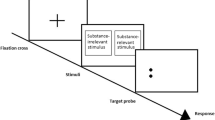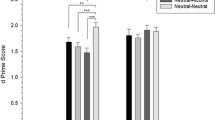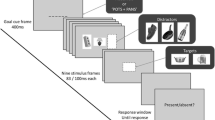Abstract
Individuals with substance use disorder (SUD) tend to have attention bias to drug and negative emotions, which leads to drug craving and relapse. This study examines attentional bias from the time dimension, and adopts the rapid sequence visual presentation (RSVP) paradigm to study the attentional blink effect of individuals with SUD towards different types of negative words. A total of 55 males with SUD were recruited from a compulsory drug rehabilitation center in Jiangxi Province. The results indicated that the following: (1) The accuracy of T2 recognition when T1 was correctly recognized (T2|T1) increased with the increase of the time interval, indicating that the attentional blink was successfully induced. (2) When T1 was addictive vocabulary, compared with the neutral vocabulary, the attentional blink effect of males with SUD was enhanced. When T2 was negative addiction vocabulary or negative vocabulary, compared with the neutral vocabulary, the attentional blink of males with SUD was weakened. The current research results not only find that males with SUD have an attention bias towards addiction clues from the time characteristics of the attention process, but also it is of great significance to guide the rehabilitation centers to improve the craving and relapse of males with SUD by reducing the appearance of negative addictive information.




Similar content being viewed by others
Abbreviations
- SUD:
-
Substance use disorder
- RSVP:
-
Rapid sequence visual presentation paradigm
- T2|T1:
-
The accuracy of T2 recognition when T1 was correctly recognized
- VSTM:
-
Visual short-term memory
References
Anderson, A., & Phelps, E. A. (2001). Lesions of the human amygdala impair enhanced perception of emotionally salient events. Nature, 411(6835), 305–309.
Anderson, G. D., & Chan, L.-N. (2016). Pharmacokinetic drug interactions with tobacco, cannabinoids and smoking cessation products. Clinical Pharmacokinetics, 55(11), 1353–1368.
Baker, A., Kim, M., & Hoffman, J. E. (2021). Searching for emotional salience. Cognition, 214, 104730.
Baker, T. B., Piper, M. E., McCarthy, D. E., Majeskie, M. R., & Fiore, M. C. (2004). Addiction motivation reformulated: An affective processing model of negative reinforcement. Psychological Review, 111(1), 33.
Baskin-Sommers, A., Wolf, R., Buckholtz, J., Warren, C., & Newman, J. (2012). Exaggerated attention blink response in prisoners with externalizing. Journal of Research in Personality, 46(6), 688–693.
Berardino, B. G., Fesser, E. A., Belluscio, L. M., Gianatiempo, O., Pregi, N., & Cánepa, E. T. (2019). Effects of cocaine base paste on anxiety-like behavior and immediate-early gene expression in nucleus accumbens and medial prefrontal cortex of female mice. Psychopharmacology (berl), 236(12), 3525–3539.
Binion, V. J. (1982). Sex differences in socialization and family dynamics of female and male heroin users. Journal of Social Issues, 38(2), 43–57.
Blalock, L. D. (2015). Stimulus familiarity improves consolidation of visual working memory representations. Attention, Perception, & Psychophysics, 77(4), 1143–1158.
Brevers, D., Cleeremans, A., Bechara, A., Laloyaux, C., Kornreich, C., Verbanck, P., & Noël, X. (2011a). Time course of attentional bias for gambling information in problem gambling. Psychology of Addictive Behaviors, 25(4), 675.
Brevers, D., Cleeremans, A., Tibboel, H., Bechara, A., Kornreich, C., Verbanck, P., & Noël, X. (2011b). Reduced attentional blink for gambling-related stimuli in problem gamblers. Journal of Behavior Therapy and Experimental Psychiatry, 42(3), 265–269.
Campbell, D. W., Stewart, S., Gray, C. E., Ryan, C. L., Fettes, P., McLandress, A. J., & Dell’Aquila, R. (2018). Chronic cannabis use and attentional bias: Extended attentional capture to cannabis cues. Addictive Behaviors, 81, 17–21.
Carretié, L., Mercado, F., Tapia, M., & Hinojosa, J. A. (2001). Emotion, attention, and the ‘negativity bias’, studied through event-related potentials. International Journal of Psychophysiology, 41(1), 75–85.
Choisdealbha, Á. N., Piech, R. M., Fuller, J. K., & Zald, D. H. (2017). Reaching back: The relative strength of the retroactive emotional attentional blink. Scientific Reports, 7(1), 1–9.
Chou, W.-P., Lee, K.-H., Ko, C.-H., Liu, T.-L., Hsiao, R. C., Lin, H.-F., & Yen, C.-F. (2017). Relationship between psychological inflexibility and experiential avoidance and internet addiction: Mediating effects of mental health problems. Psychiatry Research, 257, 40–44.
Christiansen, P., Schoenmakers, T. M., & Field, M. (2015). Less than meets the eye: Reappraising the clinical relevance of attentional bias in addiction. Addictive Behaviors, 44, 43–50.
Christie, J., & Klein, R. (1995). Familiarity and attention: Does what we know affect what we notice? Memory & Cognition, 23(5), 547–550.
Chun, M. M., & Potter, M. C. (1995). A two-stage model for multiple target detection in rapid serial visual presentation. Journal of Experimental Psychology: Human Perception and Performance, 21(1), 109.
Cole, P. M., Michel, M. K., & Teti, Laureen O’Donnell. (1994). The development of emotion regulation and dysregulation: A clinical perspective. Monographs of the Society for Research in Child Development, 59(2/3), 73–100. https://doi.org/10.2307/1166139.
Cole, P. M., Teti, L. O., & Zahn-Waxler, C. (2003). Mutual emotion regulation and the stability of conduct problems between preschool and early school age. Development and Psychopathology, 15(1), 1–18. https://doi.org/10.1017/s0954579403000014
DePalma, F. M., Ceballos, N., & Graham, R. (2017). Attentional blink to alcohol cues in binge drinkers versus non-binge drinkers. Addictive Behaviors, 73, 67–73.
Di Lollo, V., Kawahara, J.-I., Ghorashi, S. S., & Enns, J. T. (2005). The attentional blink: Resource depletion or temporary loss of control? Psychological Research Psychologische Forschung, 69(3), 191–200.
Dux, P. E., & Harris, I. M. (2007). On the failure of distractor inhibition in the attentional blink. Psychonomic Bulletin & Review, 14(4), 723–728. https://doi.org/10.3758/BF03196828
Ersche, K. D., Bullmore, E. T., Craig, K. J., Shabbir, S. S., Abbott, S., Müller, U., & Sahakian, B. J. (2010). Influence of compulsivity of drug abuse on dopaminergic modulation of attentional bias in stimulant dependence. Archives of General Psychiatry, 67(6), 632–644.
Fabio, R., & Caprì, T. (2019). Automatic and controlled attentional capture by threatening stimuli. Heliyon, 5(5), e01752.
Fals-Stewart, W., & Lam, W. K. (2010). Computer-assisted cognitive rehabilitation for the treatment of patients with substance use disorders: A randomized clinical trial. Experimental and Clinical Psychopharmacology, 18(1), 87.
Fehr, T., Wiedenmann, P., & Herrmann, M. (2006). Nicotine Stroop and addiction memory—An ERP study. International Journal of Psychophysiology, 62(2), 224–232.
Field, M., & Cox, W. M. (2008). Attentional bias in addictive behaviors: A review of its development, causes, and consequences. Drug and Alcohol Dependence, 97(1–2), 1–20.
Field, M., Marhe, R., & Franken, I. H. (2014). The clinical relevance of attentional bias in substance use disorders. CNS Spectrums, 19(3), 225–230.
Field, M., Munafò, M. R., & Franken, I. H. (2009). A meta-analytic investigation of the relationship between attentional bias and subjective craving in substance abuse. Psychological Bulletin, 135(4), 589.
Fox, E., Russo, R., & Dutton, K. (2002). Attentional bias for threat: Evidence for delayed disengagement from emotional faces. Cognition & Emotion, 16(3), 355–379.
Fox, H., Hong, K., & Sinha, R. (2008). Difficulties in emotion regulation and impulse control in recently abstinent alcoholics compared with social drinkers. Addictive Behaviors, 33(2), 388–394.
Geng, L., Jiang, T., & Han, D. (2011). Relationships among self-esteem, self-efficacy, and faith in people in Chinese heroin abusers. Social Behavior and Personality: An International Journal, 39(6), 797–806.
Gonzalez-Cuevas, G., Martin-Fardon, R., Kerr, T. M., Stouffer, D. G., Parsons, L. H., Hammell, D. C., … Weiss, F. (2018). Unique treatment potential of cannabidiol for the prevention of relapse to drug use: preclinical proof of principle. Neuropsychopharmacology, 43(10), 2036–2045.
Grant, D. S. (2014). Has social media begun to" sponsor" addiction recovery?: A study of face-to-face versus online sobriety support. Fielding Graduate University.
Gruber, S. A., Rogowska, J., & Yurgelun-Todd, D. A. (2009). Altered affective response in marijuana smokers: An FMRI study. Drug and Alcohol Dependence, 105(1–2), 139–153.
Hartikainen, K. M. (2021). Emotion-attention interaction in the right hemisphere. Brain Sciences, 11(8), 1006.
Hughes, J. R., Keenan, R. M., & Yellin, A. (1989). Effect of tobacco withdrawal on sustained attention. Addictive Behaviors, 14(5), 577–580.
Keinan, G., Friedland, N., Kahneman, D., & Dan, R. (1999). The effect of stress on the suppression of erroneous competing responses. Anxiety Stress & Co**, 12(4), 455–476.
Kelly, J. F., Hoeppner, B. B., Urbanoski, K. A., & Slaymaker, V. (2011). Predicting relapse among young adults: Psychometric validation of the advanced warning of relapse (AWARE) scale. Addictive Behaviors, 36(10), 987–993.
Klein, A. A., Nelson, L. M., & Anker, J. J. (2013). Attention and recognition memory bias for alcohol-related stimuli among alcohol-dependent patients attending residential treatment. Addictive Behaviors, 38(3), 1687–1690.
Koob, G. F. (2013). Negative reinforcement in drug addiction: The darkness within. Current Opinion in Neurobiology, 23(4), 559–563.
Koster, E. H., Raedt, R. D., Verschuere, B., Tibboel, H., & De Jong, P. J. (2009). Negative information enhances the attentional blink in dysphoria. Depression and Anxiety, 26(1), E16–E22.
Liu, N., Li, B., Sun, N., & Ma, Y. (2008). Effects of addiction-associated and affective stimuli on the attentional blink in a sample of abstinent opiate dependent patients. Journal of Psychopharmacology, 22(1), 64–70.
Marques-Teixeira, J. E., & Barbosa, M. F. S. (2005). Emotional states and informational brain processing in drug addicts free of drugs: An ERPs study. International Journal of Psychiatry in Clinical Practice, 9(3), 213–220.
McGivern, C., Curran, D., & Hanna, D. (2021). Alcohol attention bias in 14–16 year old adolescents: An eye tracking study. Psychopharmacology (berl), 238(3), 655–664.
McHugo, M., Olatunji, B. O., & Zald, D. H. (2013). The emotional attentional blink: What we know so far. Frontiers in Human Neuroscience, 7, 151.
Metrik, J., Aston, E. R., Kahler, C. W., Rohsenow, D. J., McGeary, J. E., Knopik, V. S., & MacKillop, J. (2016). Cue-elicited increases in incentive salience for marijuana: Craving, demand, and attentional bias. Drug and Alcohol Dependence, 167, 82–88. https://doi.org/10.1016/j.drugalcdep.2016.07.027
Modi, P., Malik, L., Punia, V., Kumar, K., & Dogra, R. (2019). Attentional biases for alcohol-Stroop test in patients with alcohol dependence. Open Journal of Psychiatry & Allied Sciences, 10(2), 155–158.
Mogg, K., Bradley, B. P., De Bono, J., & Painter, M. (1997). Time course of attentional bias for threat information in non-clinical anxiety. Behaviour Research and Therapy, 35(4), 297–303. https://doi.org/10.1016/S0005-7967(96)00109-X
Nieuwenstein, M. R., Potter, M. C., & Theeuwes, J. (2009). Unmasking the attentional blink. Journal of Experimental Psychology: Human Perception and Performance, 35(1), 159.
Nunes, E. V., Sullivan, M. A., & Levin, F. R. (2004). Treatment of depression in patients with opiate dependence. Biological Psychiatry, 56(10), 793–802.
Ogawa, T., & Suzuki, N. (2004). On the saliency of negative stimuli: Evidence from attentional blink 1. Japanese Psychological Research, 46(1), 20–30.
Pecchinenda, A., Monachesi, B., & Laeng, B. (2020). Fearful expressions of rapidly presented hybrid-faces modulate the lag 1 sparing in the attentional blink. Acta Psychologica, 209, 103124.
Powis, B., Griffiths, P., Gossop, M., & Strang, J. (1996). The differences between male and female drug users: Community samples of heroin and cocaine users compared. Substance Use & Misuse, 31(5), 529–543.
Pratto, F., & John, O. P. (1991). Automatic vigilance: The attention-grabbing power of negative social information. Journal of Personality and Social Psychology, 61(3), 380.
Raymond, J. E., Shapiro, K. L., & Arnell, K. M. (1992). Temporary suppression of visual processing in an RSVP task: An attentional blink? Journal of Experimental Psychology: Human Perception and Performance, 18(3), 849.
Rizzo, M., Akutsu, H., & Dawson, J. (2001). Increased attentional blink after focal cerebral lesions. Neurology, 57(5), 795–800. https://doi.org/10.1212/wnl.57.5.795
Robinson, T. E., & Berridge, K. C. (1993). The neural basis of drug craving: An incentive-sensitization theory of addiction. Brain Research Reviews, 18(3), 247–291.
Robinson, T. E., & Berridge, K. C. (2008). The incentive sensitization theory of addiction: Some current issues. Philosophical Transactions of the Royal Society b: Biological Sciences, 363(1507), 3137–3146.
Robinson, T. E., & Kolb, B. (2004). Structural plasticity associated with exposure to drugs of abuse. Neuropharmacology, 47, 33–46.
Schwabe, L., Merz, C. J., Walter, B., Vaitl, D., Wolf, O. T., & Stark, R. (2011). Emotional modulation of the attentional blink: The neural structures involved in capturing and holding attention. Neuropsychologia, 49(3), 416–425.
Shapiro, K. L., Raymond, J. E., & Arnell, K. M. (1997). The attentional blink. Trends in Cognitive Sciences, 1(8), 291–296.
Sigurjónsdóttir, Ó., Sigurðardóttir, S., Björnsson, A. S., & Kristjánsson, Á. (2015). Barking up the wrong tree in attentional bias modification? Comparing the sensitivity of four tasks to attentional biases. Journal of Behavior Therapy and Experimental Psychiatry, 48, 9–16.
Soleimannejad, M., Tehrani-Doost, M., Khorrami, A., Joghataei, M. T., & Pishyareh, E. (2015). Evaluation of attention bias in morphine and methamphetamine abusers towards emotional scenes during early abstinence: An eye-tracking study. Basic and Clinical Neuroscience, 6(4), 223.
Stewart, J., De Wit, H., & Eikelboom, R. (1984). Role of unconditioned and conditioned drug effects in the self-administration of opiates and stimulants. Psychological Review, 91(2), 251.
Stewart, J. L., Silton, R. L., Sass, S. M., Fisher, J. E., Edgar, J. C., Heller, W., & Miller, G. A. (2010). Attentional bias to negative emotion as a function of approach and withdrawal anger styles: An ERP investigation. International Journal of Psychophysiology, 76(1), 9–18.
Stewart, S. H., & Conrod, P. J. (2008). Anxiety disorder and substance use disorder co-morbidity: Common themes and future directions. In Anxiety and substance use disorders (pp. 239–257): Springer.
Sun, M., Liu, F., Cui, L., Wei, P., & Zhang, Q. (2021). The effect of fearful faces on the attentional blink is modulated by emotional task relevance: An event-related potential study. Neuropsychologia, 162, 108043.
Swan, G., Wyble, B., & Chen, H. (2017). Working memory representations persist in the face of unexpected task alterations. Attention, Perception, & Psychophysics, 79(5), 1408–1414.
Tiffany, S. T. (1990). A cognitive model of drug urges and drug-use behavior: Role of automatic and nonautomatic processes. Psychological Review, 97(2), 147–168. https://doi.org/10.1037/0033-295x.97.2.147
Trippe, R. H., Hewig, J., Heydel, C., Hecht, H., & Miltner, W. (2007). Attentional Blink to emotional and threatening pictures in spider phobics: Electrophysiology and behavior. Brain Research, 1148(none), 149–160.
Volkow, N. D., Fowler, J. S., Wang, G.-J., Swanson, J. M., & Telang, F. (2007). Dopamine in drug abuse and addiction: Results of imaging studies and treatment implications. Archives of Neurology, 64(11), 1575–1579.
Vollstädt-Klein, S., Loeber, S., Von der Goltz, C., Mann, K., & Kiefer, F. (2009). Avoidance of alcohol-related stimuli increases during the early stage of abstinence in alcohol-dependent patients. Alcohol & Alcoholism, 44(5), 458–463.
Vujanovic, A. A., Wardle, M. C., Liu, S., Dias, N. R., & Lane, S. D. (2016). Attentional bias in adults with cannabis use disorders. Journal of Addictive Diseases, 35(2), 144–153.
Walton, M. A., Blow, F. C., & Booth, B. M. (2001). Diversity in relapse prevention needs: Gender and race comparisons among substance abuse treatment patients. The American Journal of Drug and Alcohol Abuse, 27(2), 225–240.
Wang, Y., Zhou, L., & Luo, Y. (2008). Preliminary compilation and evaluation of Chinese emotional word system. Chinese Journal of Mental Health, 22(8), 5.
Waters, A. J., & Feyerabend, C. (2000). Determinants and effects of attentional bias in smokers. Psychology of Addictive Behaviors, 14(2), 111.
Waters, A. J., Heishman, S. J., Lerman, C., & Pickworth, W. (2007). Enhanced identification of smoking-related words during the attentional blink in smokers. Addictive Behaviors, 32(12), 3077–3082.
Waters, A. J., Shiffman, S., Sayette, M. A., Paty, J. A., Gwaltney, C. J., & Balabanis, M. H. (2003). Attentional bias predicts outcome in smoking cessation. Health Psychology, 22(4), 378.
Wiers, R. W., & Stacy, A. W. (2006). Implicit cognition and addiction. Current Directions in Psychological Science, 15(6), 292–296.
**e, W., & Zhang, W. (2016). Negative emotion boosts quality of visual working memory representation. Emotion, 16(5), 760.
Zeng, X., & Tan, C. (2021). The relationship between the family functioning of individuals with drug addiction and relapse tendency: A moderated mediation model. International Journal of Environmental Research and Public Health, 18(2), 625.
Acknowledgements
The authors wish to thank participants and staff in Jiangxi compulsory drug rehabilitation center.
Funding
This work was supported by the National Social Science Foundation of China (grant numbers 19BGL230), and the “13th Five-Year Plan” Project of Educational Science in Jiangxi Province (grant numbers 20YB19).
Author information
Authors and Affiliations
Contributions
Mengyao Lu: software, writing—original draft, reviewing, editing and submission; Chenxin Lian, writing—original draft, reviewing, and editing, data collection; **aoqing Zeng: conceptualization, methodology, visualization, writing—original draft, reviewing, and editing.
Corresponding author
Ethics declarations
Ethics Approval and Consent to Participate
The study was carried out in accordance with the principles of the Declaration of Helsinki. This study was approved by the Drug rehabilitation Administration of Jiangxi Province, China, and approved by the Ethics Committee of Psychology College of Jiangxi Normal University. All participants were asked to obtain the informed consent form in written. All respondents answer was kept confidential.
Conflict of Interest
The authors declare no competing interests.
Additional information
Publisher’s Note
Springer Nature remains neutral with regard to jurisdictional claims in published maps and institutional affiliations.
Rights and permissions
About this article
Cite this article
Lu, M., Lian, C. & Zeng, X. An Attentional Blink Research on Different Types of Words in Male with Substance Use Disorder. Int J Ment Health Addiction 22, 494–512 (2024). https://doi.org/10.1007/s11469-022-00885-z
Accepted:
Published:
Issue Date:
DOI: https://doi.org/10.1007/s11469-022-00885-z




